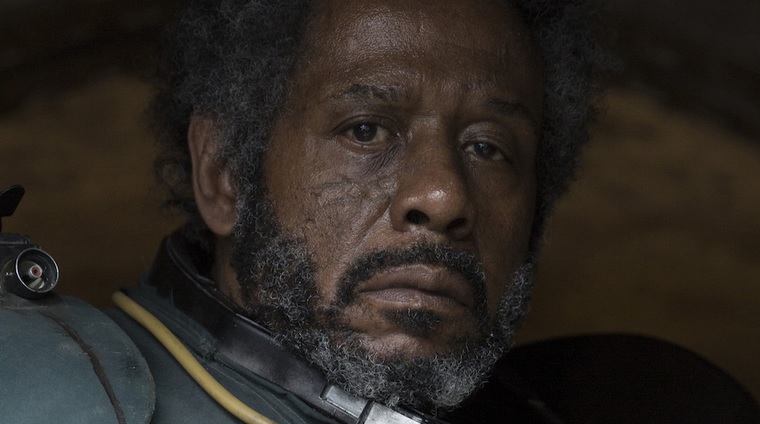
“The Mentor believes that Rebellions are built on hope, but I don’t believe it. Rebellions are built on hate” – Staven, Battlefront II: Inferno Squad
Last year I wrote about the ways in which the value system of Star Wars as defined by the Force apply not just to the journeys of its Force-sensitive characters, but also to its politics. Movements of power and self-interest – whether the greedy exploitation of the Trade Federation or the militaristic authoritarianism of the Empire – represent the fear, hatred and selfishness of the dark side, while peace is found in the compassion, harmony and symbiosis of the light.
With Rogue One as its centerpiece, Lucasfilm’s recent work has largely focused on the build-up to the Galactic Civil War, adding new political context to the iconic conflict that defines the original trilogy. Yet for all the talk of new “shades of grey”, the core values of Star Wars have ultimately been reinforced rather than subverted.
With Saw Gerrera’s return to Star Wars Rebels in “In the Name of the Rebellion,” his conflicts with Mon Mothma and with Jedi philosophy were brought to the forefront. This article will look at why, in the moral universe of Star Wars, his conduct and motivations are such a problem, and the wider dilemma of understanding a story that teaches us both that evil must be fought, while also warning that violence is the path to evil.
Fighting and the Force in the Lucas era
There is no question that the original trilogy teaches us that we must stand up to evil. An initially reluctant Luke is forced into action against the Empire after the slaughter of his guardians. Han Solo’s flaw is his selfishness, and his redemption in A New Hope is his return to the fight, while Lando Calrissian’s attempts to remain neutral fail when he realizes you can’t make a deal with evil – at some point, you will be forced to take a stand.
Yet in The Empire Strikes Back, Yoda teaches Luke that a Jedi should never use the Force to attack – only for knowledge and defense. The very act of taking his lightsaber into the dark side cave is a symbol of the aggression that would cause him to fall, a message reinforced by his moment of victory in Return of the Jedi – the throwing away of his weapon, a refusal to fight or to kill. How are we to reconcile these two messages?
The difference appears to be in the underlying motivations and emotional state of Luke. Fighting when you have no other choice, to stand in defense of others, is Good; fighting from a place of anger or hatred is Bad. The ethics of Star Wars are not consequentialist – it has a strong value system and motivations are as important as results. Fighting with anger – tapping into the dark side – may yield quick, positive results, but it will come at a great cost, which will ultimately be your soul.
Lucas further explored these ideas in The Clone Wars, where the very act of joining the war corrupted the Jedi, leading them to consider assassinations and executions in Christie Golden’s Dark Disciple. Producer Dave Filoni, as ever taking his cue from his work with Lucas, brought this theme into the Rebellion era in the Rebels episode “Shroud of Darkness,” where Yoda states to Ezra Bridger: “In our arrogance, join the conflict swiftly we did. Fear, anger, hate. Consumed by the dark side, the Jedi were.”
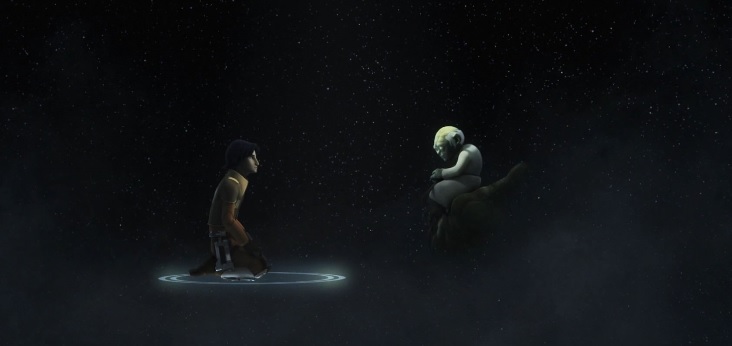
The Clone Wars, though, are a morally grey conflict, in politics if not in conduct (the Separatist armies are more than willing to commit war crimes from the beginning). The lines in the Galactic Civil War are clearer. Yet Yoda’s warning shows that the old morality still applies – fight using anger or hatred in an attempt to destroy evil, and you will fail even if you win. “How Jedi choose to win, the question is.” The defining Jedi virtue is compassion, and it is useful to make an analogy with Buddhism, where compassion is defined as the act of easing other beings from suffering, without judgement and without exception. Fear, anger, and hatred lead – as Yoda says in The Phantom Menace – to an increase of suffering in the world, and Anakin Skywalker’s fall follows this warning to the letter.
As with politics, though, these values do not just apply to our Force-sensitive characters – they can be extrapolated to warfare at large.
A Rebellion Built on Hate
Twisted by grief and guilt over the death of a loved one, there isn’t much of him left – he strides on metal limbs, encased in an iron lung. All he has left is his hatred, driving him to make the galaxy right again, however many innocents must suffer along the way.
Darth Vader … or Saw Gerrera?
Saw has been a fascinating addition to the Star Wars universe. Created by George Lucas for the unmade live action TV show, given a backstory in TCW and then moving into Rogue One and Rebels, the rebel extremist is motivated by a burning hatred for the Empire that seems tied up with his guilt over the death of his sister, Steela. That rage turns outwards in acts of violence, with little regard for civilians who might be caught in the crossfire.
Rogue One itself barely explores Gerrera’s tactics on Jedha, but we get a greater sense of them in Greg Rucka’s Guardians of the Whills. Chirrut Îmwe and Baze Malbus are struggling to process the devastation of their city and their temple. While Chirrut works to maintain a serenity and connection with the Force, Baze struggles with his fury at the Empire, and seeks a way to fight. The pair are drawn to Gerrera’s war, but even Baze draws the line when Saw’s partisans prioritize the destruction of an Imperial ship over the lives of orphans. To find redemption, our heroes rise above Gerrera’s way of doing things, and even if Baze never quite overcomes his anger, he ultimately falls down on the side of compassion – easing the suffering of the orphans.
For all its “shades of grey,” Rogue One also takes a clear line on the difference between Saw’s way of doing things, and that of the Alliance. Jyn Erso, a former child soldier of Saw’s, begins the film lacking direction. In Beth Revis’s prequel novel Rebel Rising, we learn of Jyn’s rage against everything and everyone – Empire and Rebels alike. Raised surrounded by hate, she has become an empty shell. When Jyn finds a purpose, it does not come from hatred of the Empire or even a desire for revenge over the deaths of her parents. Instead she is inspired by the rational, patient sacrifice of her father, and more than anything – as the movie repeatedly tells us – hope. Hope is the belief that a better world is possible, in this case a galaxy free from the suffering caused by the Empire. Rogue One is a story of damaged people, struggling with their anger and their guilt, finding a way to fight from a place of hope, not hate.
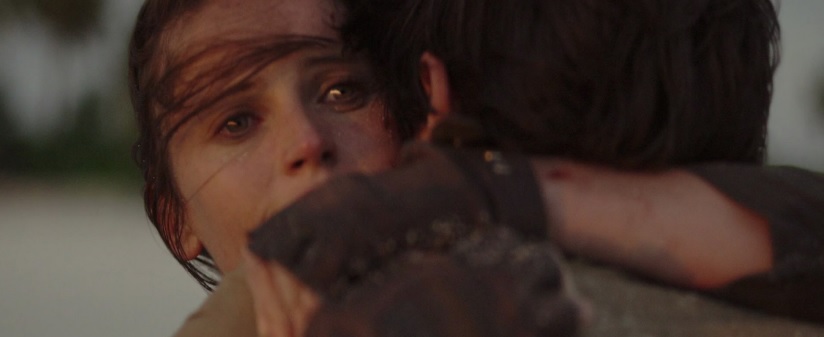
This is why it is crucial that Jyn does not kill Director Krennic at the end of the film. Though she clearly hates him, her story must rise above petty revenge. She becomes something greater. Her life and her character have still been shaped by Gerrera, but she has found a redemption and a peace within herself that her mentor never achieved. Ultimately, her moment of victory is one of self-sacrifice – all we can ask for from a true Star Wars hero.
In terms of the wider politics, “In The Name of the Rebellion” explores in more detail the disagreement between Gerrera and Mon Mothma. Ezra, Sabine Wren and even Hera Syndulla are tempted by Gerrera’s ways, the quick and easy solutions offered by giving in to anger. Gerrera’s logic – that fighting on “the Empire’s terms” is doomed to failure – is tempting, and he speaks with a passion that Mothma lacks.
However, we also know that his assertion that Mothma’s way will lead to the Empire’s victory is incorrect. In Claudia Gray’s Leia: Princess of Alderaan, Mothma argues that “there comes a time when refusing to stop violence can no longer be called nonviolence. We cease to be objectors and become bystanders.” Her motivation is easing the suffering of others, trying to find a peaceful solution while acknowledging that there comes a point where pure pacifism is complicity. Yet even in the fighting, she maintains her ethical code, and refuses to target civilians or torture prisoners. For all Saw’s mockery, Mothma’s path leads to a better galaxy, while Gerrera’s hatred burns with the rest of Jedha.
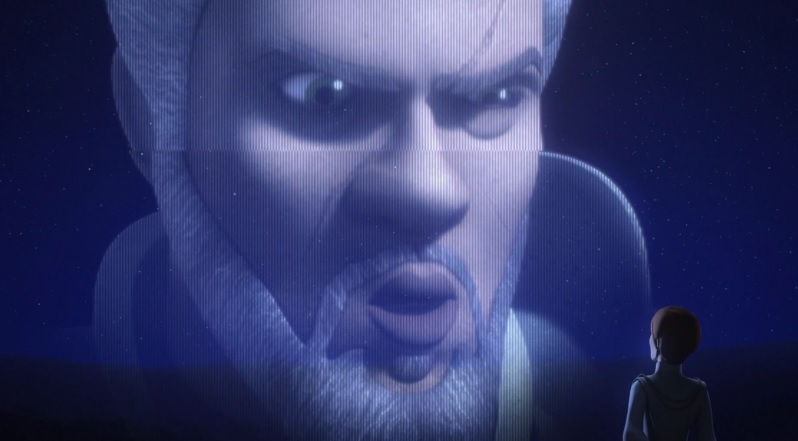
Saw shows what happens when a good person becomes consumed by guilt, anger and hatred. The innocents of Jedha suffer as much from him as from the Empire, and he sees their deaths as justified if it means hurting Imperials. Consumed by his negative emotions, he loses his moral compass, and his logic is not so very different from Vader’s. Do we really believe he would turn down the power of the dark side if it were available to him? Or even the Death Star?
Whether or not we agree with their applicability to real-world politics, these values are at the core of Star Wars, the light side and the dark. Subvert or dilute them too much – have the heroes win from a place of hatred and violence, however “justified” – and you risk destroying the thing that makes it Star Wars.
A New War
The coordinated storytelling we have seen through Rebels, Rogue One and its tie-in novels has yet to be seen to the same extent in the sequel era, so it’s hard to know how far these themes will be explored. The First Order, though, is already separated from the Empire by its unrestrained hatred, embodied in the sneering fury of General Hux. Where the Empire stood for order, and its evil was its authoritarianism, the First Order is more raw and perhaps more frightening – Evil with a capital E. Its non-Force-sensitive characters embody the evil of the dark side more clearly than the likes of Admiral Piett or even Grand Moff Tarkin.
Maz Kanata warned in The Force Awakens that the First Order must be fought, but will the question of how to fight be raised in either of its sequels? Going into The Last Jedi, we should look for Luke’s attitude toward the Resistance and the idea of fighting in general, but we shouldn’t restrict ourselves to the Force-sensitives. Pay close attention to the motivations and actions of Finn, Poe Dameron and Rose Tico, because with an enemy more extreme than the Empire, there is a danger that the Resistance will be tempted by even more extreme measures to counter them.
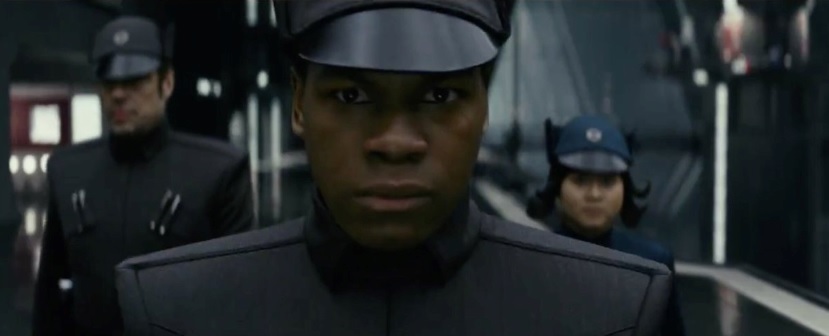

I, too, hope that the Sequels remain consistent with the message of the previous movies – thus far, it seems as though Lucasfilm is doing so.
I’ve been disappointed with much of Saw’s portrayal, because in many ways he seems like the world’s worst guerilla. His desire to strike at the Empire regardless of consequence isn’t just an ethical shortcoming, but a strategic one. For example, Mon Mothma’s decision not to destroy the Empire’s communications relay makes a lot more sense that Saw’s insistence that it be destroyed, because Mon is right – the Empire will just rebuild the relay if it is destroyed, while hijacking the relay will provide the Rebels with a more durable strategic advantage (and the relay can always be destroyed later). Saw’s unwillingness to take even basic steps to preserve civilian lives is also pretty counterproductive – guerillas rely on some level of popular support to sustain their insurgency, so fighting the Empire with no consideration for the welfare of bystanders is also a bone-headed move.
That doesn’t mean that Saw and Mon might not still have differences over how to prosecute the conflict – for example, guerillas have strong incentives to place civilians in the line of fire *under certain circumstances* when the ensuing collateral damage will be perceived as the government’s fault, a policy that we might expect Mon to resist. To date, though, I’ve found that the effort to build Saw’s ethical ambiguity has been undermined by portraying him as not just unethical, but also rather unintelligent.